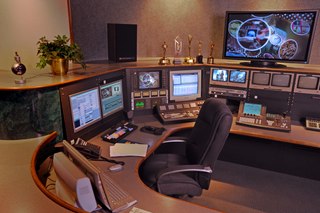
Digital video is an electronic representation of moving visual images (video) in the form of encoded digital data. This is in contrast to analog video, which represents moving visual images in the form of analog signals. Digital video comprises a series of digital images displayed in rapid succession, usually at 24 frames per second. Digital video has many advantages such as easy copying, multicasting, sharing and storage.

In information technology, lossy compression or irreversible compression is the class of data compression methods that uses inexact approximations and partial data discarding to represent the content. These techniques are used to reduce data size for storing, handling, and transmitting content. The different versions of the photo of the cat on this page show how higher degrees of approximation create coarser images as more details are removed. This is opposed to lossless data compression which does not degrade the data. The amount of data reduction possible using lossy compression is much higher than using lossless techniques.

Non-linear editing is a form of offline editing for audio, video, and image editing. In offline editing, the original content is not modified in the course of editing. In non-linear editing, edits are specified and modified by specialized software. A pointer-based playlist, effectively an edit decision list (EDL), for video and audio, or a directed acyclic graph for still images, is used to keep track of edits. Each time the edited audio, video, or image is rendered, played back, or accessed, it is reconstructed from the original source and the specified editing steps. Although this process is more computationally intensive than directly modifying the original content, changing the edits themselves can be almost instantaneous, and it prevents further generation loss as the audio, video, or image is edited.

DVD-Audio is a digital format for delivering high-fidelity audio content on a DVD. DVD-Audio uses most of the storage on the disc for high-quality audio and is not intended to be a video delivery format.

Final Cut Pro is a professional non-linear video-editing application initially developed by Macromedia, and, since 1998, by Apple as part of its pro apps collection. Final Cut Pro allows users to import, edit, and process video footage, and output it to a wide variety of formats.
The Adaptive Multi-Rateaudio codec is an audio compression format optimized for speech coding. AMR is a multi-rate narrowband speech codec that encodes narrowband (200–3400 Hz) signals at variable bit rates ranging from 4.75 to 12.2 kbit/s with toll quality speech starting at 7.4 kbit/s.
Transcoding is the direct digital-to-digital conversion of one encoding to another, such as for video data files, audio files, or character encoding. This is usually done in cases where a target device does not support the format or has limited storage capacity that mandates a reduced file size, or to convert incompatible or obsolete data to a better-supported or modern format.
Video production is the process of producing video content for video. It is the equivalent of filmmaking, but with video recorded either as analog signals on videotape, digitally in video tape or as computer files stored on optical discs, hard drives, SSDs, magnetic tape or memory cards instead of film stock. There are three stages of video production: pre-production, production, and post-production. Pre-production involves all of the planning aspects of the video production process before filming begins. This includes scriptwriting, scheduling, logistics, and other administrative duties. Production is the phase of video production which captures the video content and involves filming the subject(s) of the video. Post-production is the action of selectively combining those video clips through video editing into a finished product that tells a story or communicates a message in either a live event setting, or after an event has occurred (post-production).
The Technology and Engineering Emmy Awards, or Technology and Engineering Emmys, are one of two sets of Emmy Awards that are presented for outstanding achievement in engineering development in the television industry. The Technology and Engineering Emmy Awards are presented by the National Academy of Television Arts and Sciences (NATAS), while the separate Primetime Engineering Emmy Awards are given by its sister organization the Academy of Television Arts & Sciences (ATAS).
The Hauppauge MediaMVP is a network media player. It consists of a hardware unit with remote control, along with software for a Windows PC. Out of the box, it is capable of playing video and audio, displaying pictures, and "tuning in" to Internet radio stations. Alternative software is also available to extend its capabilities. It can be used as a front-end for various PVR projects.
Pirated movie release types are the different types of pirated movies and television series that end up on the Internet. They vary wildly in rarity and quality due to the different sources and methods used for acquiring the video content, in addition to encoding formats. Pirated movie releases may be derived from cams, which have distinctly low quality; screener and workprint discs or digital distribution copies (DDC), telecine copies from analog reels, video on demand (VOD) or TV recordings, and DVD and Blu-ray rips. They are seen in P2P networks, pirated websites and video sharing rarely on websites such as YouTube and Dailymotion due to their strict copyright rules.
Orb was a freeware streaming software that enabled users to remotely access all their personal digital media files including pictures, music, videos and television. It could be used from any Internet-enabled device, including laptops, pocket PC, smartphones, PS3, Xbox 360 and Wii video game consoles.
The following is a list of H.264/MPEG-4 AVC products and implementations.
AXMEDIS is a set of European Union digital content standards, initially created as a research project running from 2004 to 2008 partially supported by the European Commission under the Information Society Technologies programme of the Sixth Framework Programme (FP6). It stands for "Automating Production of Cross Media Content for Multi-channel Distribution". Now it is distributed as a framework, and is still being maintained and improved. A large part of the framework is under open source licensing. The AXMEDIS framework includes a set of tools, models, test cases, documents, etc. supporting the production and distribution of cross media content.
HTTP Live Streaming is an HTTP-based adaptive bitrate streaming communications protocol developed by Apple Inc. and released in 2009. Support for the protocol is widespread in media players, web browsers, mobile devices, and streaming media servers. As of 2019, an annual video industry survey has consistently found it to be the most popular streaming format.
Ingex is an open-source (GPL) suite of software for the digital capture of audio and video data, without the need for traditional audio or video tape or cassettes. Serial digital interface (SDI) capture is supported, as well as real-time transcoding. Portions of the software suite also act as a network file server for media files, as well as archiving to LTO-3 data tape. Audio and video media files can also be stored on USB hard drives or Network Attached Storage. The software is heavily used by the BBC, and was developed by the BBC Research Laboratory.
Content storage management (CSM) is a technique for the evolution of traditional media archive technology used by media companies and content owners to store and protect valuable file-based media assets. CSM solutions focus on active management of content and media assets regardless of format, type and source, interfaces between proprietary content source/destination devices and any format and type of commodity IT centric storage technology. These digital media files most often contain video but in rarer cases may be still pictures or sound. A CSM system may be directed manually but is more often directed by upper-level systems, which may include media asset management (MAM), automation, or traffic.
An online video platform (OVP), provided by a video hosting service, enables users to upload, convert, store and play back video content on the Internet, often via a private server structured, large-scale system that may generate revenue. Users will generally upload video content via the hosting service's website, mobile or desktop application, or other interfaces (API). An example of an OVP is YouTube. The type of video content uploaded might be anything from shorts to full-length TV shows and movies. The video host stores the video on its server and offers users the ability to enable different types of embed codes or links that allow others to view the video content. The website, mainly used as the video hosting website, is usually called the video-sharing website.
Visual Cloud is the implementation of visual computing applications that rely on cloud computing architectures, cloud scale processing and storage, and ubiquitous broadband connectivity between connected devices, network edge devices and cloud data centers. It is a model for providing visual computing services to consumers and business users, while allowing service providers to realize the general benefits of cloud computing, such as low cost, elastic scalability, and high availability while providing optimized infrastructure for visual computing application requirements.

Dacast Inc. is a French live streaming online video platform that allows businesses to broadcast and host live and on-demand video content as well as offer free or paid programming.





